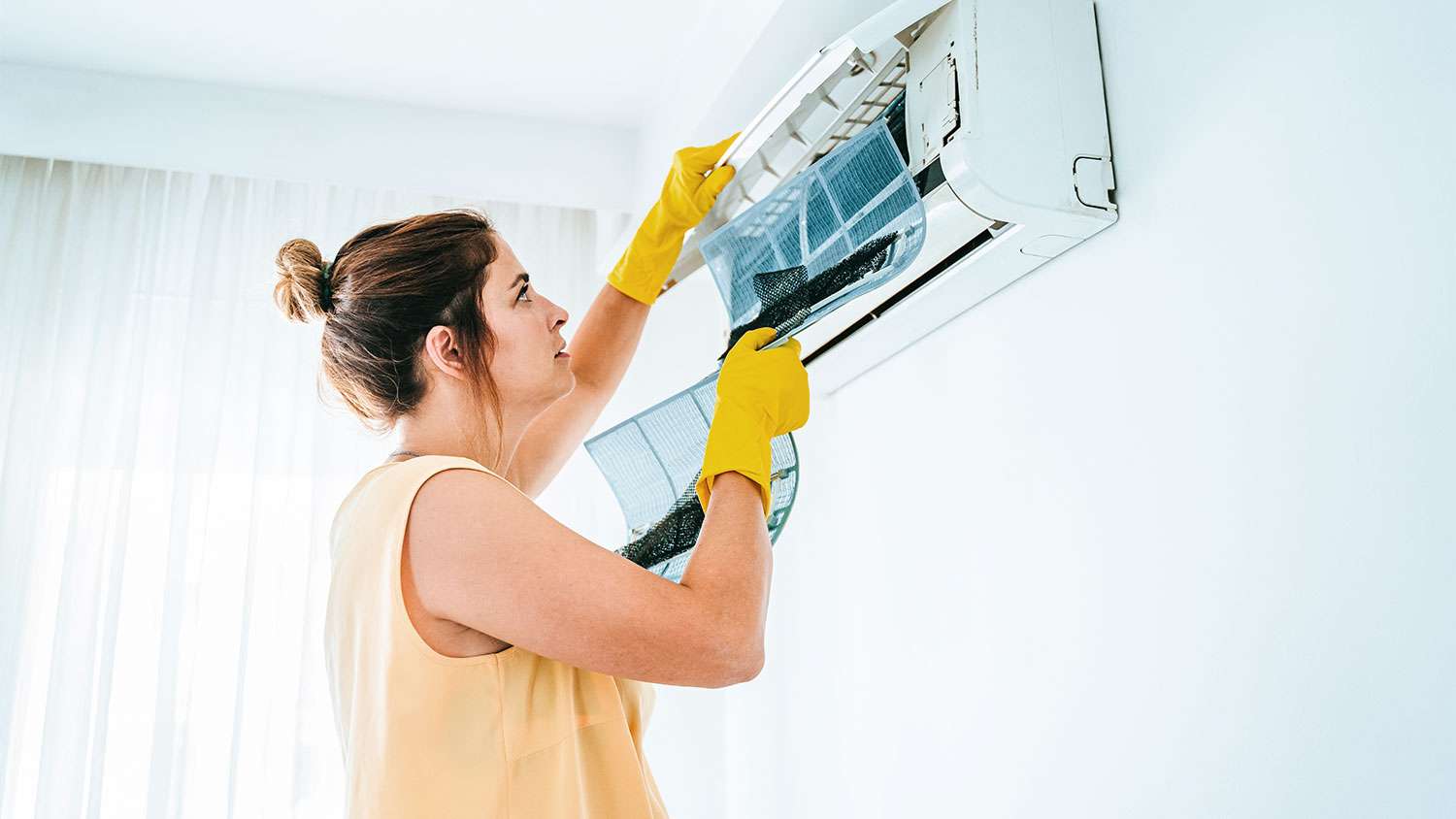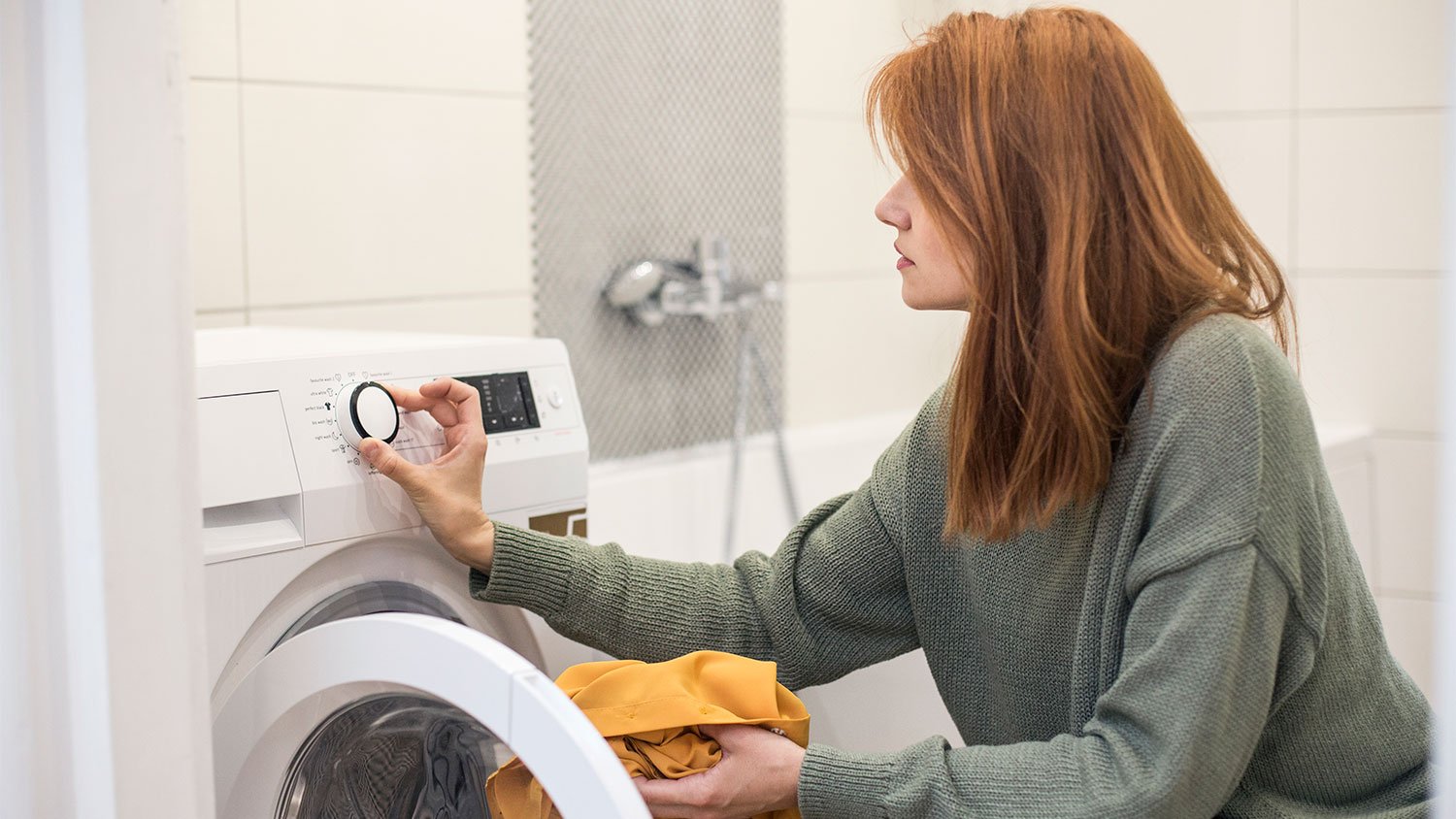How to Get Rid of Skunk Smell in Your House, on Pets, and More
Act fast to wipe out the legendary, lingering stench of skunks for good


If a real-life Pepé Le Pew sneaks onto your property and sprays you, your pet, or your favorite sofa, the overwhelming odor can be enough to send you into a blind panic. Thankfully, if you jump into action, you won’t have to worry about imminently arriving guests beating a hasty retreat. Learn how to get rid of skunk smells with some simple household items and a little elbow grease.
How to Get Rid of Skunk Smells in Your House
If a skunk gets trapped in your home and mobilizes their musk, don’t delay in taking a multi-faceted approach to purge the smell permanently.
1. Get the Air Flowing
Don’t delay in opening your windows, powering up the air conditioning, and running floor and ceiling fans at high power. Lift blinds and open curtains to let the sun stream in, helping to oxidize the odor.
2. Air Out and Clean Furniture
Don’t despair if your costly couch or another piece of prized furniture is a victim of skunk spray. Quickly move the piece into the yard to air it and start the cleaning process. You can use a commercial skunk smell removal cleaner, but steam cleaning is worthwhile for ingrained odors. If you don’t have a steam cleaner, you can rent a professional-grade model or hire a furniture upholstery cleaner near you to tackle the task.
3. Clean Your Carpets
If the skunk aerosols an area rug, it might be enough to put it in the washing machine, but how do you deal with a doused carpet? It depends on the carpet material and how much of it took a hit.
One DIY method is to use a baking soda, vinegar, and warm water solution for small patches, let it dry, and then repeat as necessary. For stubborn smells or larger areas, you should steam clean your carpet.
4. Wipe Down the Walls
Hard surfaces like wood, ceramic, vinyl, concrete, and laminate are less of a challenge to tidy up than carpets and soft furnishings. Mix nine parts water to one part bleach in a spray bottle, and then spray hard flooring and walls, wiping down with a rag or paper towels. Perform a patch test to ensure the color will hold as you clean. If you’re uncomfortable using bleach on some surface types, create a similar mixture using distilled vinegar.
5. Use Vinegar to Lift Lingering Odors
Fill several small bowls with white vinegar and leave them around the offending area for 24 to 48 hours, or until the skunk’s scent fully disperses. Vinegar has many surprising uses, and it tends to absorb and neutralize any foul odors. Keep the bowls out of reach of children and furry friends. Boiling some vinegar in a pot for a few minutes can speed up the results if the smells are stuck in your kitchen.
6. Change Air Filters

How to Get Skunk Smell Off of Clothes and Furniture
Washing affected clothes in a solution of 1 quart 3% hydrogen peroxide, ¼ cup baking soda, and 1 to 2 teaspoons of liquid dish soap and then air drying the clothing is an effective way to remove skunk odor. You can also apply this method to removable cushion covers, pillow covers, and any other textiles that can be removed from furniture. Fabric that cannot be removed can be sprayed with the mixture, rinsed, and vacuumed.
You may be able to use a steamer to remove skunk smell from upholstered furniture, especially if you have a model that works with vinegar. In all cases, make sure to do a small test on your clothing and upholstery before using hydrogen peroxide or vinegar on the fabric to ensure that it won’t stain.
How to Get Skunk Smells Off Your Pet
Curiosity, the desire to chase, and not knowing how to read the warning signs mean your pets are more likely to get skunked than you. If the spray hits their eyes, rinse them immediately with clean water.
1. Give Your Pet a Bath ASAP
The cleaning process is similar to removing any dog or cat odor. Wash your pets(ideally outside and as soon as possible) using an approved skunk-removing shampoo. Alternatively, a home remedy for skunk smell removal is to mix 1 quart of hydrogen peroxide, 1 teaspoon of grease-cutting dish detergent, and ¼ cup of baking soda. If you don’t have hydrogen peroxide, try substituting it with vinegar. Rinse well and repeat if the smell is still sticking around.
Some sensible precautions when using hydrogen peroxide include:
Wear gloves
Don’t let the lather sit for longer than five minutes (it can bleach fur)
Avoid getting it in your pet’s eyes
Stop your pet from licking themselves
Don’t store the mixture, as it can explode in a closed container
How to Get Skunk Smells Off People
Thankfully, skunk spray won’t cause any permanent injury, even if it leaves you temporarily disoriented and nauseous. But you’ll want to ditch your duds and get into the shower pronto.
1. Soak in the Soap
Scrub your hair with a deodorizing shampoo or sit in a bath with a few cups of baking soda in it for around 20 minutes to lift the lousy whiffs. This step will help neutralize the smell and wash it down the drain.
2. Wash or Toss Your Clothing

A skunk’s spray can be lethal for clothing. Unless the pest sprayed your all-time favorite T-shirt, it might be best to throw them out. Otherwise, you should wash any stinky clothing immediately. Clean these items with the highest temperature setting and use antibacterial detergent. Be sure to air dry your clothes, as machine-drying can bake in the smell.
You won’t be able to wash delicate items at high temperatures, so try soaking them in a mix of detergent and baking soda for around half an hour before rinsing and air drying.
How to Get Rid of Skunk Smells in Your Yard
When you notice a skunk smell outside your house, follow these steps as soon as possible to give the odor less time to settle in.
1. Spray Everything With Water
Use a garden hose to thoroughly spray down patios, decks, walls, fences, furniture, rugs, grass, and bushes to water down the smell—literally. This step will help to wash the smelly fluid into the soil, where it can be absorbed.
2. Create and Apply a Cleaning Solution
Fill a bucket with 1 gallon of water, 1 quart of 3% hydrogen peroxide solution, 1 cup of baking soda, and 1 teaspoon of liquid dish soap, mixing until the baking soda has dissolved.
This mixture is safe to use on most structures and furniture without causing fading or discoloration, and it won’t kill grass or plants. However, err on the side of caution and perform a patch test before pouring it everywhere.
Soak a clean cloth or sponge in the hydrogen peroxide cleaning solution and scrub all skunky surfaces. If you’ve got one, fill a backpack-style garden sprayer with the solution for easier application before scrubbing. After washing an area, rinse it thoroughly with clean water from your garden hose. You can repeat steps three and four as many times as you need until the smell fades.
Signs of a Skunk in Your Yard
You’re more likely to smell an elusive nocturnal skunk than see one. Alongside that malodorous musk, some other signs that one of these critters is a tenant in your yard include:
Circular holes in your lawn or rolled back sod from skunks digging for grubs
Bites taken out of lower sections of your garden crops
Paw print tracks that are five-toed and slightly bigger than a cat’s
Tubular droppings
Once you spot these signs, you’ll want to get rid of the skunks before they have a chance to spray.
How to Keep Skunks Away
Keeping skunks away from your home means there’s less chance of dealing with another stinky situation down the line. Use the following tips as part of your stink-free strategy:
Secure trash cans
Feed pets indoors
Don’t add kitchen scraps to the open compost pile
Tidy up bird feeder spills every evening
Mow your lawn low to keep tasty insects at bay
Block any den spots in crawl spaces or below decking
Invest in skunk-proof fencing
DIY vs. Hiring a Pro
If a skunk has gone to town on a prized piece of furniture or a delicate carpet, and you can’t shift the stench, you might need to call a professional odor removal service near you. This service will cost between $200 to $1,000, depending on your home's size and the severity of the skunk’s smell. However, getting rid of a skunk yourself could cost as little as $5 to $50, depending on what materials and cleaning tools you already have.
If the skunk is still lurking in your home after you take the above steps, you may have to hire a local animal removal service to bid them a fond farewell.
Cost to Hire an Animal Removal Specialist
Animal removal costs from $200 to $400 on average, but it may cost a bit more to apprehend a family of skunks—up to $600 depending on the level and location of the infestation. Many kinds of skunks find their way into your basement or crawlspace, so it’s a good idea to call in a pro to trap and relocate them while you reseal the new-found entrance to your home.
Gemma Johnstone contributed to this article.
Frequently Asked Questions
Skunks spray as a defense mechanism to ward off predators. The active ingredient in their sulfurous, oily musk is n-butyl mercaptan, which evaporates into a powerful and smelly gas. Once the spray hits the skunk’s target, the stench can linger for days, and water and common cleaning kits aren’t enough to wash it away.
If you happen upon a skunk in your yard, try to back away slowly to reduce the chance of them aiming at you. Encouragingly, they don’t use their weapon casually, as it can take up to 10 days for their life-saving weaponry to refill. Paw stamping, hissing, lifting their tail, and arching their back are early signs they feel trapped or under threat and that it’s time to make a careful retreat.
If you’ve spotted a skunk or know that one of these furry creatures sprayed one of your family members, your answer is fairly obvious. However, a skunky smell in your house that isn’t coming from these critters may be a sign of a dangerous gas leak. If you suspect this, leave your home immediately and call emergency services. It could also be a build-up of dangerous gas in your home’s septic system or plumbing. Call a professional plumber near you to make an assessment.
A mild skunk smell in your house can last up to three weeks, dissipating over time with proper ventilation. However, if you leave stronger smells untreated, they can last for months or years, becoming more difficult to remove the longer they sit. This is especially true of odors that have seeped into fabrics such as clothing or furniture or those in your pets’ fur.
There’s a popular notion that you can use tomato juice as a skunk odor remover, but this is just a myth. Tomato juice can temporarily mask the smell, but plays no role in chemically eliminating the foul odor.
The formula for neutralizing skunk smell is one quart of 3% hydrogen peroxide, ¼ cup baking soda, and one to two teaspoons of dish soap. The University of Nebraska says a chemist discovered that this mixture changes the thiols, the chemical compound that causes the odor, into acids that don’t carry a skunk smell, thus eliminating the odor.


